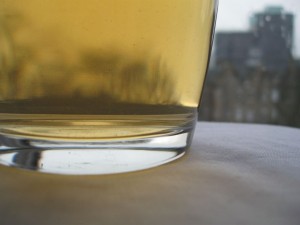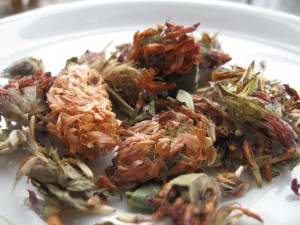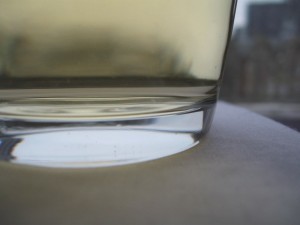Last updated: March 4, 2013
Red clover tea is a caffeine-free herbal tea made from the dried flowers and leaves of the red clover, the scientific name for which is Trifolium pratense.
The red clover is a small flower native to the area around the Mediterranean sea. It now grows all over the world. It may also be called the meadow, creeping or craw clover. It has been used as a medicinal herb for centuries by people all over the world, including Europe, East Asia and the Americas1. Modern research has revealed red clover contains isoflavones, organic compounds which mimic the behavior of estrogen in humans. This has led to relatively extensive study on the interaction between red clover and various medical conditions related to estrogen such as menopause and estrogen-sensitive cancers like breast cancer.
First I’ll give my thoughts on the tea, then I’ll give an overview of the medical evidence relating to red clover.
Appearance
Red clover tea is one of the most beautiful herbal teas I’ve tried. Loose-leaf red clover tea consists of whole dried clover flowers complete with stems and upper leaves. They’ve absolutely gorgeous. The petals range from delicate pink to bright orange against a background of grey-green.
How to make red clover tea
I like to lightly crush the red clover blossoms before I start to help them infuse with the hot water. Red clover tea takes quite a long time to fully infuse, so I would recommend using a large teapot or french press. Trying to make red clover tea in a cup using a tea ball won’t work very well as the water will cool down too fast and the tea ball probably won’t hold enough of the red clover flowers.
- In your chosen vessel, add two generous teaspoons of crushed red clover flowers per cup of boiling water. Pour the water over the clover.
- Cover and leave to infuse for at least 30 minutes. (If your tea-vessel is too small, the water will cool down too much during this time. This is an excellent time to use a tea-cozy for your teapot or to cover it with a clean cloth or towel to help keep the heat in.)
- Strain out the clover tea and serve. Add any other flavorings you like — I’m quite partial to a simple slice of lemon
Drinking red clover tea
On my first attempt, I used one teaspoon of red clover per cup of boiling water and left it to infuse for 20 minutes. The results were not satisfactory, so I tried again with 2 teaspoons per cup for 30 minutes, which yielded much better results.
Color: after 20 minutes, faint grey-green. Almost completely transparent. After 30 minutes, deep amber.
Aroma: rich, sweet, intensely savory with notes of roasted root vegetables. The aroma conjured something glazed that had been roasted long and slow in the oven with plenty of garden herbs.
The aroma was enticing even from the 20 minute infusion. I was quite taken aback; I had assumed from the anemic color that this tea wouldn’t have much going for it, but when I took a whiff I was very pleasantly surprised.
Taste: after 20 minutes, watery with a slight hint of citrus when I really went hunting for it. I was almost ready to write this tea off because the flavor was so disappointing.

Red clover tea brewed with two teaspoons per cup and infused for 30 minutes. Note the much deeper color.
On my second attempt with a longer infusion time, the taste was vastly improved. I could now taste many of the notes of the aroma: sweetness with roast vegetables. There was also a very floral element that tasted a little like honey but with a much subtler sweetness. Lingering in the background was a malty, toasted note.
I’m very glad I gave this tisane a second chance; it’s floral and delicious while still being light and refreshing.
Benefits of red clover tea
Red clover and the menopause
Red clover contains compounds which can act similarly to estrogen in the body. These compounds are known collective as phytoestrogens from the greek phyto, which means “plant”.
Because the menopause is so closely related to estrogen levels, red clover has been studies to see if it can relieve symptoms in post-menopausal women.
A 2007 meta-analysis of five clinical trials found a small effect on hot flushes:
There is evidence of a marginally significant effect of T. pratense [red clover] isoflavones for treating hot flushes in menopausal women. Whether the size of this effect can be considered clinically relevant is unclear.
A 2006 review found the following:
Research suggests that isoflavone found in [...] red clover appear to have a small but positive health effect on plasma lipid concentrations, bone mass density, cognitive abilities. Given the lack of serious safety concerns in the short term, it would appear that including [...] red clover in the diet of postmenopausal women [...] would be beneficial.
Red clover and breast cancer
The interaction between isoflavone phytoestrogens (such as those found in red clover) and estrogen-sensitive cancers like breast cancer is very complex. For example, the same phytoestrogen might act to increase activation of estrogen receptors in the body of a menopausal woman but to decrease activation of estrogen receptors in the body of a pre-menopausal woman2. Furthermore, increased activation of estrogen receptors can be desirable in some parts of the body (e.g. the brain, where it can help maintain function) but undesirable in others (e.g. breast tissue, where it might promote cancer induction)2. But phytoestrogens appear to also protect against breast cancer under some circumstances in in vitro experiments3.
The issue is more confused by the fact that red clover contains hundreds of other compounds, many of them having antioxidant or other biological activity4 that may also show a protective effect against cancer1.
In other words, while it is plausible that long-term red clover consumption may have either a negative or a positive effect on the risk of breast cancer, there is little evidence and no generally accepted conclusion.
A 2008 study of 401 women with a family history of breast cancer found that a taking a red clover supplement for 3 years appeared safe:
In conclusion, red clover isoflavones are safe, well tolerated and show no evidence of an estrogenic effect on breast density when taken for three years by women with a first-degree relative with breast cancer. [...] In post-menopausal women, no significant changes in endometrial thickness were detected. The lack of a stimulatory effect found in this study – the longest to date – is encouraging and supports the tolerability of red clover isoflavones based on epidemiological and tissue selectivity data.
Based on the overall lack of data, it’s impossible for me to reach any kind of conclusion on the relationship between red clover and estrogen-sensitive cancers like breast cancer. If you’re considering using red clover tea for medicinal purposes, you should really speak to your doctor first.
Red clover tea side effects
Aside from the discussion of safety above, no side effects specific to red clover tea are reported in the literature. In the longest clinical trial to date, the reported side effects of taking a red clover supplement were no greater than those of taking a placebo.
Final thoughts
Red clover is a beautiful tisane. When it’s allowed to infuse properly over a long period, it produces a light and delicious tea. The medical benefits of red clover tea are not clear — there seems to be a modest benefit in alleviating some symptoms of menopause but more research needs to be done.
- Trifolium L.-a review on its phytochemical and pharmacological profile [↩] [↩]
- Phytoestrogens in botanical dietary supplements: implications for cancer, p. 121 [↩] [↩]
- Phytoestrogen regulation of a Vitamin D3 receptor promoter and 1,25-dihydroxyvitamin D3 actions in human breast cancer cells [↩]
- Trifolium L.–a review on its phytochemical and pharmacological profile [↩]


